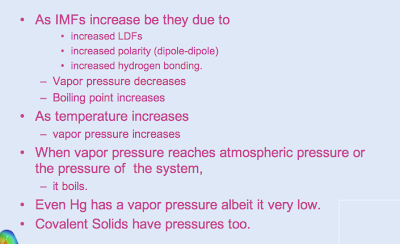This week, we learned many different concepts from Vapor Pressure to Lattice energy to Liquids and Solids. We also continued to learn about how the IMF forces affected these basic concepts and what other forces or bonds held these molecules together.
The first main concept we learned about was vapor pressure. Vapor pressure is the amount of gas of a compound that is in equilibrium with the liquid or solid. This means that if IMFs are weak in the compound, molecules can more easily break out of the liquid or even solid into the atmosphere. This concept of vapor pressure is used to explain why water evaporates when left out for a few hours. The link and images below give a better in-depth description of what vapor pressure is and what are some common trends that go along with it.
IMFs and Vapor Pressure in Depth
Later on in the week, we learned about Lattice energy in molecules. Lattice energy is the amount of energy required to completely separate a mole of a solid ionic compound into its gaseous state. The main things to know about Lattice energy is that it increases with the charge on ions and decreases with the size of these ions. Also, as Lattice energy goes up, so does the element's boiling point.
The last thing we learned about this week was about the conductivity of different compounds and their correlation with trends such as boiling point and melting point. We conducted a whole lab testing the conductivity of different substances and engaged in a rather large discussion over these concepts. We learned that testing the conductivity of a substance is really only testing the ability of the electrons in that substance to move. We worked with our table groups to complete the lab and settle any unresolved questions.
Overall, this week flew by pretty quickly. My participation this week hasn't been as great as it could be and I need to work to improve that in the upcoming weeks. I am quite nervous for the test on tuesday because I am not entirely sure about all of the concepts we will be tested on. I do not know the material very well and will need to study pretty hard tomorrow to get all of these concepts. The end of the tri is looming over us and I cannot be more excited!!!




